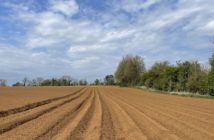After the worst Autumn/Winter for farming in living memory, Spring 2020 will see a significant shift in cropping choices.John Swire reports
Arable farmers have planted the smallest Winter cropping area in decades after relentless heavy rain and flooding across the country. As of 14th February (source AHDB planting survey), just 1.2m hectares out of the typical 1.8m hectares has been planted.
With Winter cropping now ruled out for some, tough choices will have to made in terms of whether to Spring crop or fallow unsuitable fields in need of repair for a good early start next Autumn.
Sarah Ferrie, marketing manager Interagro says: “Unplanned Spring cropping could be a challenge, particularly where soils need remedial work to prepare seedbeds ahead of drilling. With the wet warm Autumn conditions, coupled with soil disturbance, growers should be prepared for potentially higher black-grass germination than normal. To be effective, residual herbicides require good coverage across the soil surface to ensure contact with all germinating weeds. Cloddy seedbeds should therefore be minimised where possible to prevent further protracted emergence of weed seed.
“Herbicide applications in suboptimal conditions could exacerbate the threat of germinating weeds getting missed. In suboptimal conditions, ultra fine spray droplets can drift off target, leading to poor coverage in some parts of the field. Weeds that do not come into contact with the herbicide at emergence will not be controlled.”
The addition of adjuvant Backrow however, will help alleviate these risks by creating the perfect droplet size for pre- and peri-emergence herbicide applications. Backrow reduces the number of fine spray droplets prone to drift and increases the number of spray droplets in the optimum size range for better coverage.
Upon application, herbicides need to be activated – unless incorporating some rainfall will be required to move herbicide from the soil surface to the weed root zone (top 5cm) but the amount depends on soil type and soil moisture ahead of activation. Certainly Spring crops going in as soon as weather allows, will be full of moisture, particularly on heavy clays. Thinking about herbicide placement in the soil should be a key consideration for growers.
“For residual herbicides to control weeds, they must be absorbed into the roots and shoots of weeds at germination – herbicides dissolved in soil water move into weeds as they absorb water from the soil. For this to happen, herbicides needs moisture to be in soil solution (of which there is currently plenty) and must be retained in the top 5cm of the soil as this is the typical depth at which weeds germinate. With the excessive moisture in soils, and particularly if further heavy rainfall occurs after application, herbicides with high mobility can be lost from the top 5cm, moving deeper into the soil. This risks crop injury if allowed to move to the roots, and movement to groundwater if the herbicide is highly mobile,” added Mrs Ferrie.
“Backrow retains herbicides in the top 5cm of the soil, which will reduce the risk of herbicides leaching to crop roots and potential threat to groundwater. This could be crucial where using herbicides such as metazachlor, dimethenamid-P, imazamox, clomazone or flufenacet. It will also be useful if protracted weed germination does occur.”
Should conditions miraculously dry up and growers are planting into soils with limited moisture, herbicide performance may also be impacted as insufficient soil moisture may be present for effective uptake into weed roots. This can be particularly problematic when applying herbicides that have high adsorption (Koc) values, such as pendimethalin, picolinafen and aclonifen. Such herbicides have a high tendency to bind to organic matter, and bind even tighter in dry soils. They are therefore less “available” for uptake into weeds in dry conditions, or soils with organic matter/clay content that have a high number of adsorptive binding sites. However, with good moisture, more of the herbicide is released from soil colloids and can be taken up by weed roots.
“Backrow helps to retain soil moisture in the top 5cm of the soil and therefore can be particularly beneficial in light soils where moisture is easily lost, dry soils, soils with high organic matter and using herbicides such as pendimethalin., adds Mrs Ferrie.
Encouraging results
Despite developing grass challenges in the Scottish borders, agronomist Greig Baird from Agrii has seen encouraging results adding Backrow to the pre-emergence mix.
“I look after veg and cereal crops in the low ends of Scotland, North Northumberland and the Scottish borders. Like many farms across the UK, we’re tackling new challenges – conditions have been much drier over the past couple of years. As always, grass-weed control remains a priority for farmers and a huge part of my job – especially with the herbicide resistance issues we are now faced with.
In terms of the grass challenges experienced, things up here look a little different. While not on the scale seen throughout the rest of the UK, we are starting to see patches of black-grass creep into Scotland now. Annual meadow grass and brome are among the biggest issues we face on farms; brome in particular is hard to keep on top of. As we know, when competition from these weeds gets too much – the effects on the crop can be devastating.
The August-November season is all about cereals; I’m working a lot with barley and oilseed rape at the moment. As resistance mounts and legislation tightens, it’s vital to ensure farmers are able to make the most out of the tools still available to them. As a business, we’ve invested a great deal of time and energy seeking out a solution to eke every ounce of activity out of our herbicides and remove the risks that threaten efficacy.
With pre-emergence herbicides, getting the most out of the chemistry means making sure it’s held in the top layer of soil where it can make maximum contact with germinating weeds. Unfortunately, poor seed beds and difficulty during application make it hard to achieve the right level of control. Where we’re dealing with light soils, herbicides with a low absorption also tend to leach.
In the past three or four years, incorporating the Backrow adjuvant into the pre-emergence mix has helped us sidestep many of these issues, creating an optimum droplet size, delivering better coverage and helping us improve control in dry soils.
As a company, we have quite a big trial system in place, allowing us to test and assure quality for a couple of years before bringing products to our farmers commercially. Tested alongside a number of similar products, Backrow has stood out in terms of improvement and efficacy – increasing black-grass control by 9%. As a direct result, we now incorporate Backrow into the full range of pre-emergence armoury.
I find the product to be as useful in spring as I do in the autumn – if not more so. With the carrot and potato crops I look after, the drier the conditions, the better the efficacy of the product. I believe that spring barley pre-emergence for annual meadow grass could be a great market for Backrow. In terms of top tips, I usually apply Backrow at 0.2l/ha in the autumn and then 0.4l/ha in the spring – although if seedbed conditions are moist in the spring I may use 0.2l/ha.
It’s still early days, but it’s fair to say we have seen extremely encouraging results with Backrow so far.”




